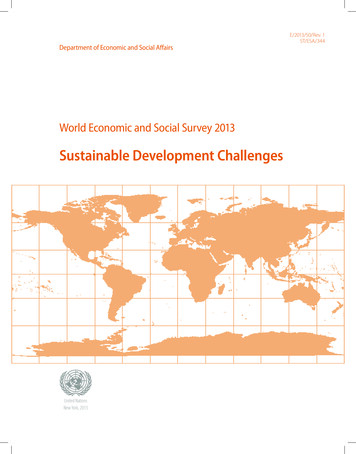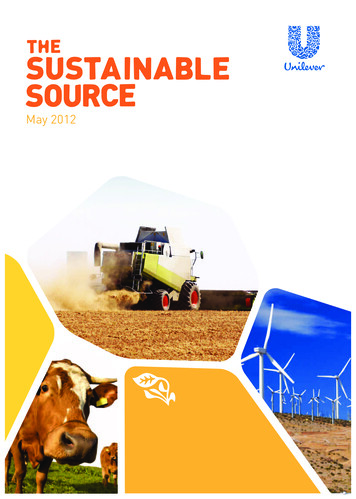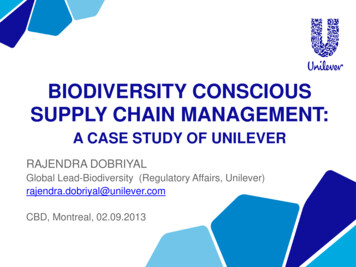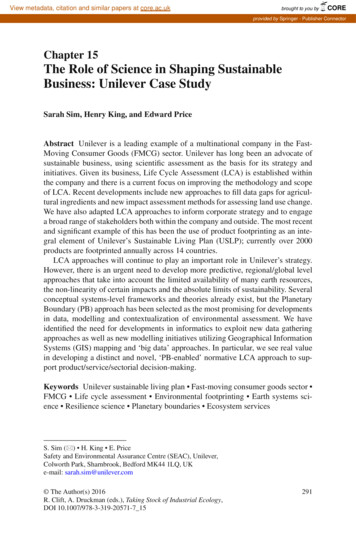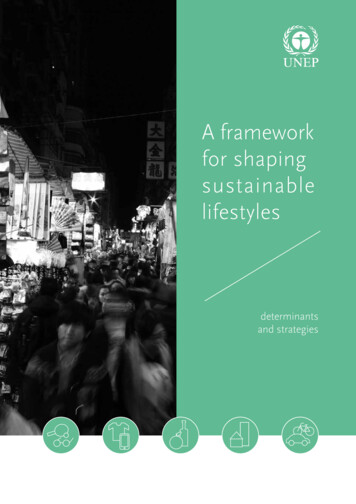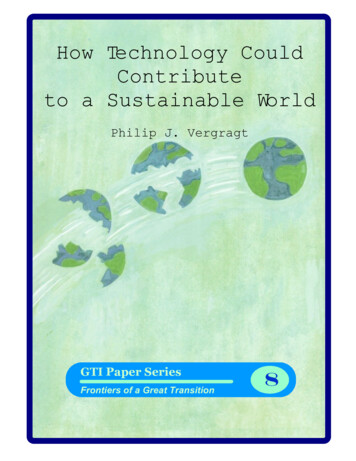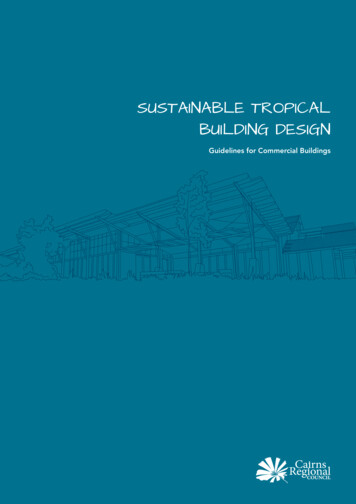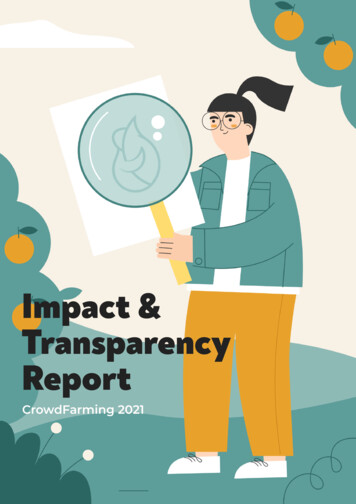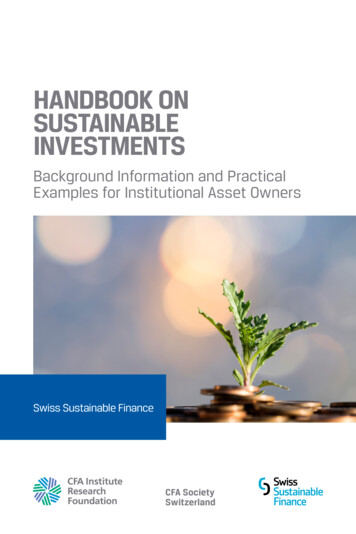
Transcription
HANDBOOK ONSUSTAINABLEINVESTMENTSBackground Information and PracticalExamples for Institutional Asset OwnersSwiss Sustainable FinanceCFA SocietySwitzerland
HANDBOOK ONSUSTAINABLEINVESTMENTSBackground Information and PracticalExamples for Institutional Asset OwnersSwiss Sustainable FinanceCFA SocietySwitzerland
Statement of PurposeThe CFA Institute Research Foundation is anot-for-profit organization established to promotethe development and dissemination of relevantresearch for investment practitioners worldwide.Neither the Research Foundation, CFA Institute, nor the publication’s editorial staff is responsible for facts and opinions presented in this publication.This publication reflects the views of the author(s) and does not representthe official views of the CFA Institute Research Foundation.The CFA Institute Research Foundation and the Research Foundation logo are trademarksowned by the CFA Institute Research Foundation. CFA , Chartered Financial Analyst ,AIMR-PPS , and GIPS are just a few of the trademarks owned by CFA Institute. To viewa list of CFA Institute trademarks and the Guide for the Use of CFA Institute Marks, pleasevisit our website at www.cfainstitute.org. 2017 Swiss Sustainable FinanceNo part of this publication may be reproduced, stored in a retrieval system, or transmitted,in any form or by any means, electronic, mechanical, photocopying, recording, or otherwise,without the prior written permission of the copyright holder.This publication is designed to provide accurate and authoritative information in regard tothe subject matter covered. It is sold with the understanding that the publisher is not engagedin rendering legal, accounting, or other professional service. If legal advice or other expertassistance is required, the services of a competent professional should be sought.Cover Image Photo Credit: Getty Images/Jose A. Bernat BaceteISBN 978-1-944960-35-3
ContentsForeword.v1. Summary of the Sustainable Investment Handbook.2. Introduction. . .19Part 1: Sustainable Investments in Context.3. Sustainable Investments and Institutional Investorsin Switzerland — Overview of Current Status and Developments. . .4. The Performance of Sustainable Investments —An Overviewof Academic Studies. . .5. Development of the Regulatory and Legislative Environmentfor Sustainable Investment.12Part 2: Different Approaches to Sustainable Investmentand Specific Asset Classes. . .6. Introduction to Different Approaches to SustainableInvestment.7. Exclusions. . .Case Study: Velux Foundation.8. Best-in-Class Approach. . .Case Study: Eltaver AG.9. ESG Integration Approach.9.1. Enhancing the Investment Process through ESG Integration. . .9.2. Optimised Geographical Asset Allocation Thanksto ESG Integration.9.3. The Role of ESG Integration in Emerging Market Investments.Case Study: Zurich Insurance Group.10. Exercising Voting Rights. .Case Study: Pension Fund of the City of Zurich.11. Shareholder Engagement —Dialogue with Companies. . .Case Study: PUBLICA Federal Pension Fund.11.1. Shareholder Engagement: Experiences of a Swiss InvestorCollective.Case Study: CAP Prévoyance. . .12. Sustainable Thematic Investments. 131724333438454752546062646769757783868890iii
13. Impact Investing.13.1. Investments for Development. . .13.2. Microfinance.14. Green Bonds.15. Sustainable Infrastructure Investments.16. Sustainable Private Equity Investments.17. Sustainable Real Estate. . .18. Integrating Sustainability into Commodity Investing. . .97103110112116121125129Part 3: Special Themes. . .19. Climate Change and Associated Risks for Investors.Case Study: Nest Collective Foundation.20. The Role of Indices in Sustainable Investment. .Case Study: Swissport Company Pension Fund.21. Transparency of Sustainable Investments. . .134135143146153155Part 4: Steps to Implementation. . 15922. Implementing a Sustainable Investment Policy—A Practical Guide. 160Appendix. . 178List of Abbreviations. . 178Glossary. . . 180This publication qualifies for 4 CE credits, 0.5 SER, under theguidelines of the CFA Institute Continuing Education Program.
ForewordGoing LongThe craft and science of investing is essentially about optimising performanceby either achieving the maximum future return for any given risk level orminimising risk for a defined return goal, all the while being exposed tofundamental uncertainty about the future. There is little room for additionalgoals in this equation.Or so you think!A fast-growing share of investors have recently widened their scope ofanalysis to criteria regarded as extra-financial. They are driven by differentmotivations. Adoption of sustainable investment strategies can be driven, onthe one hand, by the sole motivation to hedge portfolios against knowablerisks by expanding the conceptual framework to incorporate the latest bestpractice in risk management. Other investors focus on a long-term view andmake an active bet on societal change. Recent empirical research has shownthat considering sustainability factors within investment practices does notcome at a cost (i.e., through a reduced opportunity set) but allows for competitive returns. Furthermore, the growing market and resulting competitionin the wake of sustainable investing going mainstream has the welcome effectof compressing fees for such products. Hence, staying informed about recenttrends in sustainable investing is imperative no matter what the main motivation is.This is where this publication, prepared by Swiss Sustainable Finance(SSF) and translated by the CFA Institute Research Foundation, comes in.Its practical insights into different approaches of sustainable investments,complemented with case studies from different asset owners, permits thereader to gain a comprehensive overview of contemporary best practice in sustainable investing.The financial industry has a long history of imposing its values and practices onto the real economy. While in the case of the increasing financialisation of our world this might have raised concerns, for sustainable investing itcan turn into an opportunity. If taking on a longer-term view and rewarding v
Handbook on Sustainable Investmentscorporate sustainability turns into the new normal, this might counteract theever shorter time horizons of market participants. Such a shift is in perfectconformity with the CFA Institute mission “to lead the investment professionglobally by promoting the highest standards of ethics, education, and professional excellence for the ultimate benefit of society.”Sabine DöbeliCEO, Swiss Sustainable Financevi Christian Dreyer, CFACEO, CFA Society Switzerland
1. Summary of the Sustainable InvestmentHandbookPart 1: Sustainable Investments in ContextChapter 3. Sustainable Investments and Institutional Investors inSwitzerland—Overview of Current Status and Developments Sustainable investments are increasingly important for Swiss institutionalinvestors. Some cantonal pension funds have regulations that require sustainabilitycriteria to be taken into consideration when investing. The Swiss market for sustainable investments is growing faster than theoverall market. This includes internally managed sustainable assets ofinstitutional investors.Chapter 4. The Performance of Sustainable Investments—AnOverview of Academic Studies Financial markets fail to take full account of the risks and benefits associated with a company’s ESG performance. This creates potential opportunities for investors. This finding has been confirmed by numerous scientific studies that analyse the impact of various ESG aspects on a company’s performance. For sustainability funds, the results are mixed. However, many studies show that sustainable investments do not adversely affect financialperformance.Chapter 5. Development of the Regulatory and LegislativeEnvironment for Sustainable Investment France, the Netherlands, and the United Kingdom have the most highlydeveloped regulation concerning sustainable investment compared withthe rest of Europe. Swiss pension funds have a legal obligation as equity shareholders toactively vote. 1
Handbook on Sustainable Investments The integration of sustainability themes in the investment process isconsistent with the fiduciary duties of institutional investors, if not arequirement.Part 2: Different Approaches to Sustainable Investmentand Specific Asset ClassesChapter 6. Introduction to Different Approaches to SustainableInvestmentChapter 7. Exclusions Exclusion criteria are an established approach to sustainable investment,intended to reflect the investors’ values within their investments. Any detrimental impact on performance can be compensated by modifying the exclusion criteria, optimising the portfolio, or combining theapproach with other ESG strategies.Case Study: Velux Foundation A foundation increases its impact through sustainable investment.Chapter 8. Best-in-Class Approach The best-in-class approach is a method for selecting businesses with aconvincing record of implementing ESG measures. It allows the construction of diversified securities portfolios that arefinancially attractive and at the same time support sustainable long-termgrowth.Case Study: Eltaver AG A family office invests in line with family values.Chapter 9. ESG Integration Approach ESG integration is the explicit inclusion of ESG opportunities andrisks in traditional financial analysis and investment decisions of assetmanagers. Sustainability factors can be an indicator of a company’s competitive advantage and influence the longer-term assumptions of financialanalysts.2
1. Summary of the Sustainable Investment Handbook An ESG integration process takes into account the long-term growthprospects, not only making a portfolio attractive from a sustainabilityperspective but also improving the risk–return profile.Chapter 9.1. Enhancing the Investment Process through ESGIntegration An example illustrates how an ESG assessment is integrated as a keycomponent of the investment process. The ESG assessment carried out by financial analysts helps them betterunderstand the value drivers and risks of a company and creates addedvalue for investors.Chapter 9.2. Optimised Geographical Asset Allocation Thanks toESG Integration Political, macroeconomic, and resource-oriented criteria are relevant foran optimised geographical asset allocation. Long-term ESG trends, which can be measured quantitatively, give anearly indication of structural changes that are not analysed by mainstreaminvestors and rating agencies.Chapter 9.3. The Role of ESG Integration in Emerging MarketInvestments The limited availability of ESG information is one of the main challengesfor an ESG integration approach in the context of emerging markets. Dialogue at the board level can provide access to senior management,thereby making it easier to access information. The ESG integration approach adds value to the investment process.Case Study: Zurich Insurance Group An insurance company integrates sustainability criteria throughout itsinvestment processes.Chapter 10. Exercising Voting Rights Exercising voting rights is an important means for shareholders to expresstheir views on what constitutes good business management. 3
Handbook on Sustainable Investments Detailed analysis of all agenda items requires substantial resources, whichis why many investors delegate their decisions to proxy advisors. Although the board’s proposals are seldom rejected in Switzerland, evena small percentage of “no” votes makes the company management moreamenable to discussing the concerns of critical shareholders and perhapsadapting the strategy.Case Study: Pension Fund of the City of Zurich A public pension fund gets involved as an active shareholder, in foreigncompanies too.Chapter 11. Shareholder Engagement—Dialogue with Companies Shareholder engagement is a long-term process aimed at systematically promoting key ESG aspects in the business practices of portfoliocompanies. Portfolio managers can use shareholder engagement as the basis for optimised investment decisions. Since it is a resource-intensive and specialised process, it may make senseto delegate engagement to an independent provider or cooperate withother investors.Case Study: PUBLICA Federal Pension Fund The Pension Fund of the Swiss Confederation joins forces with otherpublic sector investors for engagement and exclusion.Chapter 11.1. Shareholder Engagement: Experiences of a SwissInvestor Collective Pooling investors makes it possible to conduct an effective dialogue withcompanies on sustainability issues. If this improves company performance, all the involved investors willbenefit.Case Study: CAP Prévoyance A public sector pension fund focuses its investments on long-term, sustainable development.4
1. Summary of the Sustainable Investment HandbookChapter 12. Sustainable Thematic Investments Sustainable thematic investments can create value as part of a stock allocation process thanks to an attractive risk/return profile. They can help diversify a stock allocation, since they exhibit only minoroverlaps with the popular global equity indices. Combining sustainable thematic investments with ESG integration andactive shareholder ownership principles creates an advantageous sustainability profile.Chapter 13. Impact Investing Impact investments distinguish themselves from other forms of sustainable investing mainly by their intentionality to achieve a positive social orenvironmental impact and their commitment to report on the impact oroutcome of the investments (measurability). The majority of impact investing funds target the delivery of at least market-rate returns and are a suitable investment vehicle to diversify investment, as returns are often uncorrelated with those of the mainstreammarket.Chapter 13.1. Investments for Development After years of steady growth, investments for development worldwidenow exceed USD30 billion. Switzerland has assumed a leading role inthis area. This growth reflects not only a societal trend toward more sustainabilitybut also new investment opportunities in frontier markets. While microfinance investments were previously the mainstay, other sectors—particularly the energy sector—are now also gaining importance.Chapter 13.2. Microfinance Switzerland provides management and consulting services for 38% ofglobal microfinance investment, making it the world market leader in thissegment. A global microfinance index showed constant positive returns of 3–6% (inUS dollar terms) in the past eleven years, thus proving that microfinanceinvestment vehicles are extremely robust in the face of global economicweaknesses. 5
Handbook on Sustainable InvestmentsChapter 14. Green Bonds Green bonds are a suitable instrument for funding renewable energiesand hence the energy transition. The market for green bonds is based on voluntary standards and is gradually becoming more structured.Chapter 15. Sustainable Infrastructure Investments The consideration of ESG criteria is especially appropriate in the case ofinfrastructure projects due to their inherent longevity and capital intensity. Applying ESG criteria creates added value, brings additional benefits forthe environment, society, and the economy, and has the potential to makeinfrastructure investments more attractive.Chapter 16. Sustainable Private Equity Investments Private equity investors have inherent corporate governance advantagesunlike investors in other asset classes. This opens opportunities for bettersustainable investments and higher investment returns. Compared with primary or secondary investments, direct private equityexposures offer better opportunities to integrate ESG criteria and createsocial benefits.Chapter 17. Sustainable Real Estate Sustainable real estate today accounts for a significant share of the property market as a whole and offers great investment potential. Sustainable properties are economically attractive and offer riskdiversification. Green labels, performance indicators, and benchmarking initiativesincrease transparency.Chapter 18. Integrating Sustainability into Commodity Investing One of the main discussions concerning commodity investments and sustainability issues revolves around the impact of physical and derivativeinvestors on commodity prices. Investors in commodity derivatives fulfil an important role in food security through their contribution to lower price volatility, given that the6
1. Summary of the Sustainable Investment Handbookinvestments are managed actively and exclude futures contracts withmeasurable destabilising price effects. ESG issues of physical commodity investments are related to priceimpact as well as social and environmental issues along the value chain(traceability).Part 3: Special ThemesChapter 19. Climate Change and Associated Risks for Investors Climate change regulation and its impact present growing risks forinvestments. A wide range of instruments and strategies are available to investors tohelp them understand, measure, and mitigate these risks.Case Study: Nest Collective Foundation A pioneer in sustainable investment places greater emphasis on the carbon intensity of its portfolios.Chapter 20. The Role of Indices in Sustainable Investment Virtually all the major index providers today offer numerous sustainability indices based on different sustainable investment approaches. On the one hand, these indices can be used as an investment universe foractive investment strategies. On the other hand, they are also suitable forpassive strategies implemented via index-linked funds.Case Study: Swissport Company Pension Fund A tailor-made passive investment product is developed for a companypension fund.Chapter 21. Transparency of Sustainable Investments Creating transparency requires effort but fosters credibility and legitimacy through lower reputational risks. There is no defined, generally valid standard for reporting on sustainableinvestments. However, this offers flexibility to develop customised solutions based on individual requirements. 7
Handbook on Sustainable InvestmentsPart 4: Steps to ImplementationChapter 22. Implementing a Sustainable Investment Policy—APractical Guide There is no single recipe for implementing a sustainable investment policybut rather various approaches with different objectives and impacts. A suitable approach can be identified for each asset class depending onthe primary motivation. Implementation of the sustainable investment policy can be carried outinternally or outsourced to external providers. In either case, the results should be monitored on a regular basis.Reporting on the sustainable investment policy offers transparency to different stakeholders.8
2. IntroductionOver the course of more than 20 years, the advancement of sustainableinvestments1 has created a large and diverse offering that includes productsand services for virtually every asset class, geographical region, and investment strategy. These investments have proven themselves to be comparablewith conventional investment products in terms of risk and return, in manycases providing more-effective portfolio diversification. At the same time,they make an active contribution towards bringing the economy onto a moresustainable path.There are several reasons why institutional investors consider sustainability aspects when making investments. The three main criteria are complying with generally recognised international and national standards/norms or specific values defined by their own organisation withintheir investment activity, improving the risk/return profile of investments, and promoting sustainable development and business practices.More and more investors who manage wealth for third parties on a fiduciary basis have added sustainability criteria to their investment policy for oneor more of these reasons.2Recently, new regulations governing sustainability have been introducedin many European countries. The Ordinance against Excessive Compensationin Listed Corporations (VegüV)3 was Switzerland’s first bid to make activeexercising of shareholder votes on specific themes obligatory for pensionfunds. Pressure from various stakeholders is steadily mounting. These includeNGOs, who stress the responsibility of institutional investors, and members of pension funds, who want to see their assets invested in a responsiblemanner.In Switzerland, self-regulation is very important in many areas, includingsustainable investment. The need to define a sustainable investment policy ina self-determined manner—as well as being as flexible as possible in its implementation—has already encouraged a number of Swiss institutional investorsto go down this route. Many others have only just started discussions at toplevel to see whether, and how, such a step could be taken.One thing is clear: Switzerland has already built up enormous expertise in the area of sustainable investments, and anyone embarking on thatcourse will not be alone. The huge choice currently available might actually 9
Handbook on Sustainable Investmentsintimidate investors trying to get to grips with this topic for the first time.After all, it is not that simple to get a clear idea of the different approachesand decide which is most suited for a particular organisation.Swiss Sustainable Finance (SSF) has received a number of requests overtime to clarify terms or provide a clearer overview of sustainable investments both from SSF members and from other institutional investors. ThisHandbook is designed to meet that demand and offer a broad, readily understandable overview of sustainable investment as practised today in Switzerlandand elsewhere.The Handbook’s main target audience is representatives of such institutional investors as pension funds, insurance companies, foundations, andfamily offices that are looking to initiate a discussion about the implementation of a sustainable investment policy or have been instructed to developsuch a policy. This publication is thus aimed not only at the foundation boardof trustees but also at the heads of institutional investment companies, investment specialists in general, and people who deal with investment strategiesas part of their supervisory role but are not actively involved in this area on adaily basis.The Handbook is organised into four parts:Part 1: Sustainable Investments in Context describes the developmentson this theme among institutional investors in Switzerland. One chapterexamines the important question of the potential effect on the performanceof an investment portfolio of applying sustainability criteria. The last chapter describes the regulatory situation in major European countries (includingSwitzerland).Part 2: Different Approaches to Sustainable Investment and SpecificAsset Classes is the main body of the Handbook. In this section, all thecurrent approaches to sustainable investment are introduced and explained.In addition, specific sustainable asset classes that are becoming increasinglyimportant are outlined.Part 3: Special Themes explores interdisciplinary topics that are highlyrelevant for all sustainable investments. This includes the question of howclimate change—and the measures taken to combat it—affects investmentportfolios and how these impacts can be rendered measurable. Another chapter examines the role that indices play for sustainable investment. Finally, theimportance of transparent reporting for sustainable investment strategies isdiscussed.Part 4: Steps to Implementation is perhaps the most important part ofthe Handbook. In the manner of a cookbook, this lists the ingredients fordefining and implementing a sustainable investment policy. All the key steps10
2. Introductionare described—from determining the main motivation to defining the investment policy and implementing the strategy—and allocated to the variousactors within an organisation.Throughout the Handbook, there are also a number of case studies providing insights into how sustainable investment strategies are implementedby various institutional investors. The examples include a number of pensionfunds (as well as one insurance company, a foundation, and a family office)and offer a varied picture of different approaches to implementing a sustainable investment policy.Like every specialist field, sustainable investment has developed its ownterminology, which often contains abbreviations (just to make things evenmore complicated). A short glossary at the end of the Handbook explainsthe most important terms. A more detailed version can be found on the SSFwebsite, where it is updated regularly.4Taken as a whole, the Handbook clearly shows that sustainable investments have evolved into a mature market. The general idea is for the currentpublication to serve as a reference work where readers can pick out the chaptersmost relevant to them. The first chapter in Part 2, “Introduction to DifferentApproaches to Sustainable Investment,” highlights which approaches areapplicable to which asset classes and may come in useful when decidingwhich chapters to prioritise. SSF hopes you enjoy reading the Handbook anddiscovering the strategy that best suits your own organisation.EndnotesSee the Glossary for a definition of the term “sustainable investments.”See chapter 22 for background information on determining the main motivations.3Swiss Federal Council. (2014). Verordnung gegen übermässige Vergütungen bei börsenkotiertenAktiengesellschaften. /20132519/index.html.4Swiss Sustainable Finance. (2016). Glossary. nt---1--3077.html.12 11
Part 1: Sustainable Investmentsin Context12
3. Sustainable Investments andInstitutional Investors in Switzerland —Overview of Current Status andDevelopmentsJean LavilleDeputy CEO, Swiss Sustainable FinanceSustainable or responsible investments are currently gaining prominenceamong Swiss public pension schemes and charitable foundations.1 2015 was aparticularly important year for pension schemes with the creation of the newSwiss Association for Responsible Investments (SVVK-ASIR), with suchfounding members as public pension funds Compenswiss, PUBLICA, andthe Pension Fund of the Post Office. Furthermore, the association of Swissgrant-making foundations (SwissFoundations) drew up a governance code,encouraging members to include sustainability issues in their wealth management activities.Ever-Increasing FormalisationThese new initiatives come in the wake of legislative changes by the cantonsof Geneva (2014) and Vaud (2015), which now oblige their respective pension funds to comply with sustainable development and responsible investment objectives. These legislative measures compel pension funds to formalisethese policy decisions in investment regulations and responsible investmentcharters. The same is true for foundations, where such responsible investmentpolicies help them to formalise their values and objectives and apply them totheir asset management while matching them to their risk/return profile.A Fresh Look at PerformanceThe recent developments have come about following a shift in how industry participants view the impact of responsible investing on financial performance. More and more studies—both academic and practical—areshowing that
Neither the Research Foundation, CFA Institute, nor the publication s edito - rial sta is responsible for facts and opinions presented in this publication. This publication re ects the views of the author(s) and does not represent the o cial views o
